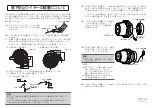
4.6 Manual flash modes M and MLo
In these modes the flash unit fires an uncontrolled
flash at full light output P 1/1 when in “M” mode
or partial light output P 1/8 when in “MLo” mode.
Adaptation to the prevailing photographic situa-
tion is by selecting a corresponding aperture on
the camera or by setting the partial light output.
The LC display of the flash unit indicates the flash-
to-subject distance required for correct flash ex-
posure (see 5.7).
Setting procedure
• Continue despressing the “Mode” key on the
flash unit until “M” or “MLo” flashes on the
display. The setting instantly becomes effective
and is automatically saved after 5 seconds.
On some cameras, the manual flash mode
“M”or “MLo” is only supported in the ma-
nual camera mode “M”. (Please refer to the
camera’s operating instructions).
5. Dedicated flash functions
Dedicated flash functions are flash functions
that have been specifically adapted to a given
camera system (Canon, Minolta, Nikon, Olym-
pus) (see Table 1). The supported flash func-
tions depend on the type of camera used. It is
impossble to describe in detail all camera
types and the individual dedicated flash func-
tions within the framework of these instruc-
tions. Therefore please refer to the flash mode
description in your camera’s operating instruc-
tions.
5.1 Flash readiness indication
The flash readiness symbol lights up on the flash
unit when the flash capacitor is charged, thereby
indicating that flashes can be fired for the next
shot. Flash readiness is also transmitted to the ca-
mera for corresponding indication in the view-
finder or on the camera’s display panel (see ca-
mera manual).
If a picture is shot before flash readiness is signal-
led, then the flash unit will not be triggered so that
the exposure may be incorrect if the camera has
☞
☞
94
ķ
703 47 0173-A2 28 AF-3 25.01.2005 15:53 Uhr Seite 94
















































